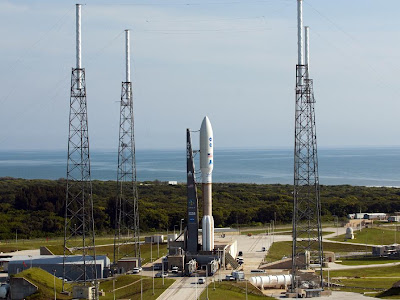 |
| JUNO's Atlas V rocket at its launch site. |
 |
| JUNO being assembled in Denver. |
 |
| Sense of scale, one of three solar array wings. |
I had Friday off and was glad I was given the opportunity to spend the morning watching the launch. The launch was scheduled for 11:34 AM on Friday, August 5, 2011. We had concerns earlier in the week that Tropical Storm Emily would cause some problems with the launch, but it turned out to be a beautiful morning for a launch.
As the countdown progressed, there were a few little problems along the way. From my limited contact, I heard there was some problem with the launch vehicles fuel pressurization. This problem turned out to be on the ground side of the equipment and the engineers and technicians sorted this problem in little time. However, the launch did push past the scheduled start of the window. During this time, there came a call that range control had given a no go. To the best of my understanding, someone had wandered into the hazardous zone, most likely a boat. Most likely someone fishing and completely oblivious to the days events.
Once the ground technical problem was solved, we continued to wait on range control to sweep the hazardous zone once again. The window for launch on Friday would close at 12:43 PM. This time was approaching fast, but eventually launched with plenty of time left in the window.
Here are a few pictures from my vantage point on the NASA Causeway, a strip of land that connects Kennedy Space Center to Cape Canaveral AFS.
These images can be clicked on to see a larger version. One thing is for certain though. I will be investing a much better camera in the future if I ever get this opportunity again.
While we waited for the countdown to resume, we got a little entertainment from the local wildlife. There were a few dolphins right in front of us playing and jumping excitedly, no doubt to send JUNO off in their own little way.
I don't recall the exact time of launch, but it came a few seconds earlier than expected. None of us out there had an official mission clock, so we just had to guess. We were close enough to get some good sound from the launch. It was similar to the shuttle launches, but somehow felt a little different. Just as loud, and shook the ground. This rocket isn't designed to take fragile humans into orbit. Since a machine can withstand much more than we can, the rocket took off much faster than the shuttle.
 |
| JUNO is on its way! |

So Juno is on its way... It will take 5 years for it to reach Jupiter. It is going out and will eventually circle back and flyby Earth again in 2 years. Its doing this to get a gravity assist in its speed. It will need as much as it can get to maintain its orbit around Jupiter. By the time it gets to Jupiter, it will traveling at 9,900 miles per hour, or about 3 miles per second. The object that holds the record for fastest object is Voyager 1 currently leaving our solar system at 38,200 miles per hour. Juno will never leave the solar system though and will end its life plunging into the clouds of Jupiter sometime in 2017.
I have been reading news reports about LEGO figurines headed to Jupiter aboard JUNO. I never heard anything about it while at work, but admittedly I have been busy with my own stuff to do. I'll check into it when I go back tomorrow morning. It would have been nice to see them in person. I'll see if I can find some pictures we took of them though. In the meantime, here is a link to a news article about it.
Only one month left now until GRAIL launches. So much to do in the following weeks. We just finished fueling both spacecraft with hydrazine. Now we have to move them out to the rocket waiting for us and encapsulate them in its fairing for its journey to the moon!
 |
| Jupiter, Juno, and Galileo |







No comments:
Post a Comment